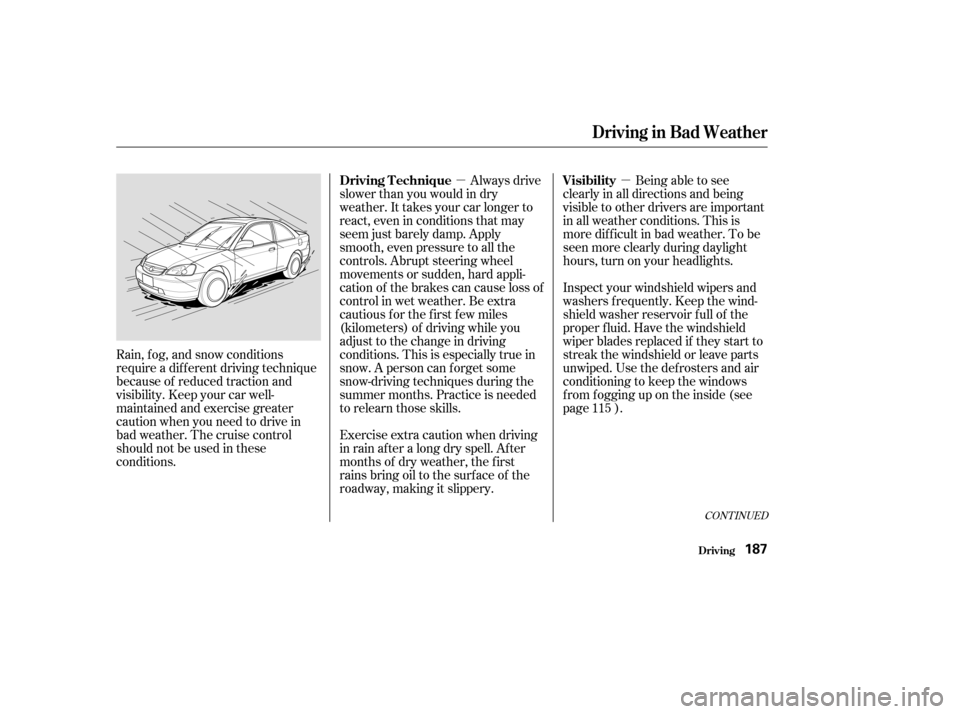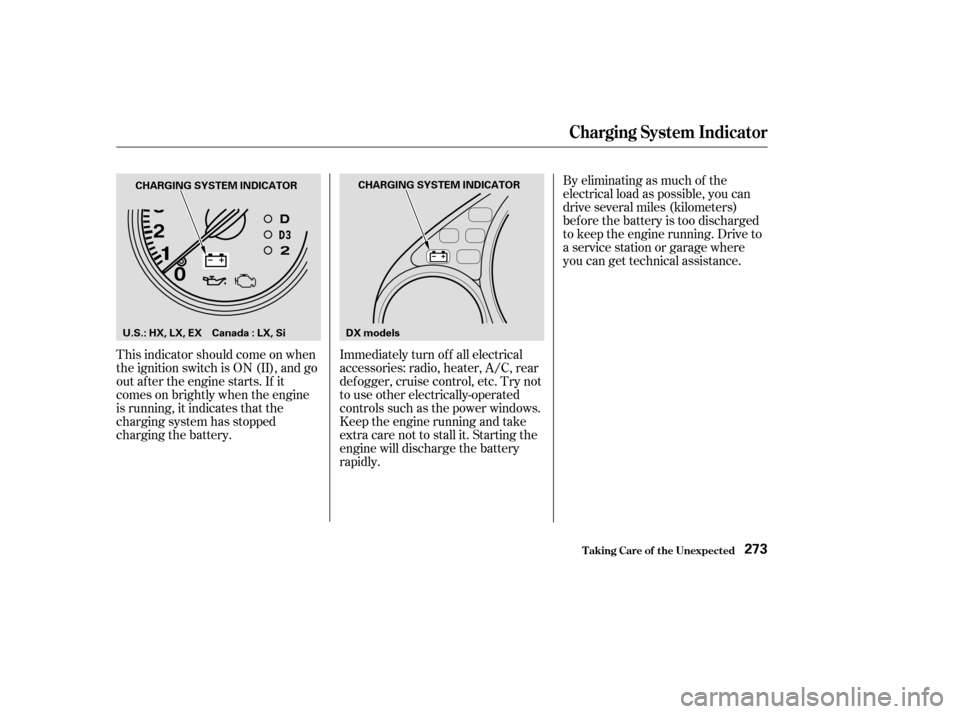Page 176 of 302

�µMake sure the moonroof and the
windows are closed.
Make sure the parking brake is f ully
released bef ore driving away.
Driving with the parking brake
partially set can overheat or damage
the rear brakes. Turn of f the lights.
Place any packages, valuables, etc.,
in the trunk or take them with you.
Lockthedoorswiththekeyorthe
remote transmitter.
Never park over dry leaves, tall
grass, or other f lammable
materials. The three way catalytic
converter gets very hot, and could
cause these materials to catch on
fire.
Always use the parking brake when
you park your car. The indicator on
the instrument panel shows that the
parking brake is not f ully released; it
does not indicate that the parking
brakeisfirmlyset.Makesurethe
parking brake is set f irmly or your
car may roll if it is parked on an
incline.
If your car has an automatic
transmission, set the parking brake
bef ore you put the transmission in
Park.Thiskeepsthecarfrom
moving and putting pressure on the
parking mechanism in the
transmission making it easier to
move the shift lever out of Park
when you want to drive away. If the car is f acing uphill, turn the
f ront wheels away f rom the curb. If
you have a manual transmission, put
it in f irst gear.
If the car is f acing downhill, turn the
f ront wheels toward the curb. If you
have a manual transmission, put it in
reverse gear.
Parking T ips
Driving
Parking
182
�����—�����—�����y�
�������������y���
�(���%�������y���
�����y
Page 181 of 302

�µ
�µ Being able to see
clearly in all directions and being
visible to other drivers are important
in all weather conditions. This is
more dif f icult in bad weather. To be
seen more clearly during daylight
hours, turn on your headlights.
Inspect your windshield wipers and
washers f requently. Keep the wind-
shield washer reservoir f ull of the
proper f luid. Have the windshield
wiper blades replaced if they start to
streak the windshield or leave parts
unwiped. Use the def rosters and air
conditioning to keep the windows
f rom f ogging up on the inside (see
page ).
Exercise extra caution when driving
in rain af ter a long dry spell. Af ter
months of dry weather, the f irst
rains bring oil to the surf ace of the
roadway, making it slippery.
Rain, f og, and snow conditions
require a dif f erent driving technique
because of reduced traction and
visibility. Keep your car well-
maintained and exercise greater
caution when you need to drive in
bad weather. The cruise control
should not be used in these
conditions. Always drive
slower than you would in dry
weather. It takes your car longer to
react, even in conditions that may
seem just barely damp. Apply
smooth, even pressure to all the
controls. Abrupt steering wheel
movements or sudden, hard appli-
cation of the brakes can cause loss of
control in wet weather. Be extra
cautious f or the f irst f ew miles
(kilometers) of driving while you
adjust to the change in driving
conditions. This is especially true in
snow. A person can f orget some
snow-driving techniques during the
summer months. Practice is needed
to relearn those skills. 115
CONT INUED
Visibility
Driving T echnique
Driving in Bad Weather
Driving187
�����—�����—�����y�
������
������y���
�(���%�������y���
�����y
Page 217 of 302
Check the battery terminals for
corrosion (a white or yellowish
powder). To remove it, cover the
terminals with a solution of baking
soda and water. It will bubble up and
turn brown. When this stops, wash it
of f with plain water. Dry of f the
battery with a cloth or paper towel.
Coat the terminals with grease to
help prevent f uture corrosion.
Check the battery condition by
looking at the test indicator window
on the battery.
The label on the battery explains the
test indicator’s colors.
Check the condition of your car’s
battery monthly. You should check
the color of the test indicator window,
and f or corrosion on the terminals.
Battery posts,
terminals, and related accessories
contain lead and lead compounds.
Battery
Maint enance
WARNING:
Wash hands af ter handling.
224
TEST INDICATOR WINDOW
�����—�����—�����y�
�������������y���
�(���%�������y���������y
Page 241 of 302

Block the rear wheels.
Fill the f uel tank.
Change the engine oil and f ilter
(see page ).
Wash and dry the exterior
completely.
Cleantheinterior.Makesurethe
carpeting, floor mats, etc. are
completely dry.
Leave the parking brake off. Put
the transmission in Reverse
(5-speed manual) or Park
(automatic).
If you need to park your car f or an
extended period (more than one
month), there are several things you
should do to prepare it f or storage.
Proper preparation helps prevent
deterioration and makes it easier to
get your car back on the road. If
possible, store your car indoors.
If the car is to be stored for a
longer period, it should be
supported on jackstands so the
tires are of f the ground.
Leave one window open slightly (if
the car is being stored indoors).
Disconnect the battery.
Support the f ront wiper blade
arms with a f olded towel or rag so
they do not touch the windshield.
To minimize sticking, apply a
silicone spray lubricant to all door
and trunk seals. Also, apply a
vehiclebodywaxtothepainted
surfaces that mate with the door
and trunk seals.Coverthecarwitha‘‘breathable’’
cover, one made f rom a porous
material such as cotton.
Nonporous materials, such as
plastic sheeting, trap moisture,
which can damage the paint.
If possible, run the engine f or a
while periodically (pref erably once
amonth).
If you store your car f or 12 months
or longer, have your Honda dealer
perf orm the inspections called f or in
the 24 months maintenance schedule
(Normal Conditions) as soon as you
take it out of storage (see page ).
The replacements called f or in the
maintenance schedule are not
needed unless the car has actually
reached that time or mileage. 194
205
St oring Your Car
Maint enance248
�����—�����—�����y�
������
������y���
�(���%�������y�������
�y
Page 246 of 302

Clean the windows, inside and out,
with a commercially-available glass
cleaner. You can also use a mixture
of one part white vinegar to ten parts
water. This will remove the haze that
builds up on the inside of the
windows. Use a sof t cloth or paper
towels to clean all glass and clear
plastic surf aces. If you use a liquid air f reshener,make sure you f asten it securely so it
does not spill as you drive.
If you want to use an air f reshener/
deodorizer in the interior of your car,
it is best to use a solid type. Some
liquid air f resheners contain chemi-
cals that may cause parts of the
interior trim and f abric to crack or
discolor.
Windows A ir Fresheners
Interior Care
Appearance Care254
The rear window def ogger and
antenna wires are bonded to the inside
of the glass. Wiping vigorously up-and-
down can dislodge and break these
wires. When cleaning the rear window,
use gentle pressure and wipe side-to-
side.
�����—�����—�����y�
�������������y���
�(���%�������y���������y
Page 264 of 302

This indicator should come on when
the ignition switch is ON (II), and go
out af ter the engine starts. If it
comes on brightly when the engine
is running, it indicates that the
charging system has stopped
charging the battery.By eliminating as much of the
electrical load as possible, you can
drive several miles (kilometers)
before the battery is too discharged
to keep the engine running. Drive to
a service station or garage where
you can get technical assistance.
Immediately turn of f all electrical
accessories: radio, heater, A/C, rear
def ogger, cruise control, etc. Try not
to use other electrically-operated
controls such as the power windows.
Keep the engine running and take
extra care not to stall it. Starting the
engine will discharge the battery
rapidly.
Charging System Indicator
T aking Care of t he Unexpect ed273
DX models
CHARGING SYSTEM INDICATOR
CHARGING SYSTEM INDICATOR
U.S.: HX, LX, EX Canada : LX, Si
�����—�����—�����y�
�������������y���
�(���%�������y���������y
Page 272 of 302
�µ
�µ
�µ
No.
CONT INUED
Amps. Circuits Protected
1 23456789
1011121314151617181920 20 A
15 A
7.5 A 20 A
10 A
15 A
15 A
20 A
10 A
40 A
40 A
40 A
40 A
40 A
15 A
20 A
15 A
80 A
40 A Condenser Fan
Small Lights
Interior Light
Cooling Fan
Hazard, Turn Signals
FI ECU
Horn, Brake Light
ABS F/S
Back Up
ABS Motor
Rear Defroster
Heater Motor
Power Window
Option
Lef t Headlight
Door Lock
Right Headlight
Not Used
Battery
Ignition 1
Spare Fuses
21 257.5 A 30 A
Fuses
T aking Care of t he Unexpect ed281
UNDER-HOOD FUSE BOX
�����—�����—�����y�
�������������y���
�(���%�������y���������y
Page 273 of 302
�µ�µ �µ �µ �µ �µ
�Î �Î
�Î
No. Amps.No. Amps.
Circuits Protected Circuits Protected
: On Canadian models
12345 15 A
20 A
10 A
10 A 6789
1011 1213141516171819202122232425 7.5 A
20 A
7.5 A 10 A
7.5 A
7.5 A
7.5 A
10 A
10 A
15 A
15 A
7.5 A 20 A
20 A
20 A
Ignition Coil
LAF Heater
Daytime Running Lights
Alternator
Not Used Power Window Relay
Moonroof
Accessory, Radio
SIDE SRS
Meter
ABS
Daytime Running Lights
SRS
Power Mirrors
(Security)
Not Used
Fuel Pump
Accessory Power Socket
Turn Signal Lights
Front Wipers
Not Used
Front Right Power Window
Front Left Power Window
Not Used
Not Used
Fuses
T aking Care of t he Unexpect ed282
INTERIOR FUSE BOX
�����—�����—�����y�
�������������y���
�(���%�������y���������y